Together with two friends I had a one-week vacation in Denmark planned in the second week of May 2016. Our main goal was visiting Legoland, as one of my friends is a huge fan of Lego. However a friend of mine told me about the “Fabergé” exhibition that was to be opened at the Koldinghus in Kolding, on 12 May. I was of course more than interested. I had been in the Koldinghus at least twice before, and enjoyed all my visits to this interesting and old royal castle. Be prepared for climbing lots of stairs when visiting the museum. However the south and east wings are accessible to those in wheelchairs. Certain areas of the west and north wings can also be accessed with some assistance. A lift is located in the east wing of the castle.
Unfortunately for me the day ended in hospital. On my way out of the museum I must have missed the last steps of the short stairs between the museum shop and the ticket office, and fell down. Luckily nothing had happened to the camera and laptop I was carrying. However I twisted my left ancle and foot badly and hurt my right knee. Furthermore I had a painful hip and it turned out later also my left leg had been bruised a bit. The blue spot on my knee disappeared within two weeks, but unfortunately it will take a few weeks before I will walk properly again. Pictures were taken in hospital, luckily nothing was broken. It could have been much worse if it had been the next stairs or if there hadn’t been a floor-mat at the bottom of the stairs. So glad it happened almost at the end of the vacation!
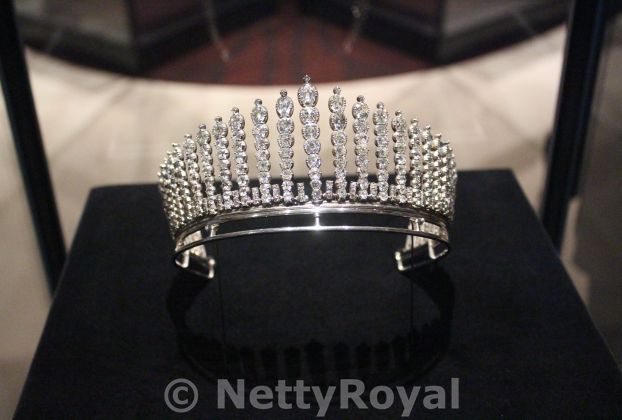
The Exhibition
The exhibition “Fabergé. The tsar’s Jeweller and the connections to the Danish royal family” (or in Danish: Fabergé. Zarens hofjuvelér og forbindelsen til den danske kongefamilie) is on display in the newly renovated Ballroom of the Koldinghus. If I counted well the huge room is situated on the fourth floor. The exhibition will be shown from 12 May to 25 September 2016.
I was impressed by the amount of royal guests at this exhibition. I was informed beforehand that the exhibition would be opened by Princess Benedikte of Denmark. Also present would be her cousins Princess Elisabeth of Denmark and Count Ingolf of Rosenborg, with his wife Countess Sussie. And furthermore on the guestlist were Alexander von Solodkoff, who is a Fabergé expert, and his wife Duchess Donata zu Mecklenburg-Schwerin von Solodkoff. I was quite surprised to discover a few more. The Mecklenburg couple had brought their daughters Thyra and Alix with them, and also Thyra Moes née Countess zu Castell-Castell, daughter of Princess Alexandrine-Louise of Denmark, was present. Furthermore I even missed one of the guests with a royal connection: Thomas Schmidt, former husband of Countess Josephine of Rosenborg. But I found him back on a few of my pictures after all.
For my photos of the exhibition see here.
Opening at 3pm in the Ruin Hall
Arrival of the guests at the Koldinghus. Welcome address by Museum Director Thomas C. Thulstrup. Presentation of the exhibition by exhibition curator Anni Nørskov Mørch. Opening speech and official opening of the exhibition by HRH Princess Benedikte of Denmark, patroness of the museum. Royals had a private tour of the exhibition and afterwards attended a private reception. Other guests visited the exhibition. Guests, including the royal ones, leave the Koldinghus.
Over the years there have been many Fabergé exhibitions all over the world, and especially the Fabergé Easter eggs still appeal to one’s imagination. Thus far I think I have only seen one of these Easter eggs, at an exhibition in Assen, The Netherlands, in 2015, but none of the imperial ones. And if you think you’ll find one in Kolding, you’re unfortunately mistaken. The Danish royal family did order and inherit quite a few Fabergé ornaments, but no Easter eggs.
The two imperial ladies who are responsible for the fact that so many Fabergé items ended up in Denmark are Empress Maria Feodorovna of Russia née Princess Dagmar of Denmark (1847-1928), the wife of Tsar Alexander III, and Grand Duchess Anastasia Michailovna of Russia (1860-1920). The latter one married Duke Friedrich Franz von Mecklenburg-Schwerin and their daughter Alexandrine married King Christian X of Denmark. Furthermore Maria Feodorovnas brother Vilhelm, the later King George I of Greece, married Grand Duchess Olga Constantinovna of Russia (1851-1926). And of course all these connections were marked with gifts, including Fabergé ornaments, that are still cherished by their relatives. In her foreword in the exhibition book the museum’s patron Princess Benedikte of Denmark says to be very pleased to be able to contribute to the exhibition and writes: “I have immense admiration for the distinguished Fabergé artefacts, and I take great pleasure in their delicate beauty and whimsical form.” Popular gifts were for example photo frames, cigarette cases and lighters, and all kind of boxes.
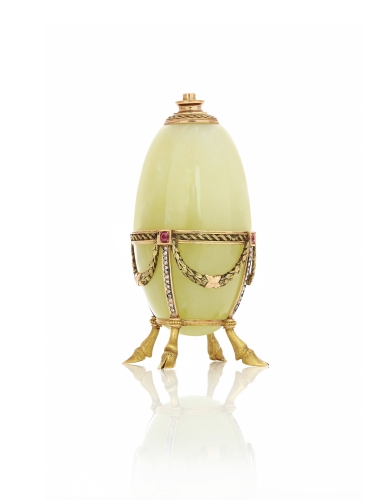
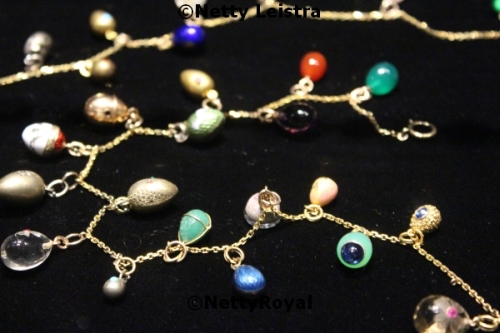
The Kolding exhibition presents about 100 artefacts, mainly from the possession of the Danish royal family. Often they are still in use. One can imagine the Koldinghus is very grateful that several family members have given items on loan for this exhibition. It is very rare that these pieces are being exhbited. And it is actually the very first time that these Fabergé objects belonging to the Danish Royal Family are being shown side by side in a single exhibition. Queen Margrethe, Prince Henrik, Princess Benedikte of Denmark, Queen Anne- Marie of Greece, Princess Elisabeth of Denmark as well as Count Ingolf and Countess Sussie kindly lent objects to the Koldinghus. Other pieces are on loan from The Royal Danish Collection at Amalienborg Palace, The Cartier Collection, Det Kongelige Løsørefideikommis and Den Kongelige Livgardes Officerskorps Fond. Not all items exhibited are from Fabergé itself tough, also some works created by Russian masters such as Ovchinnikov and Khlebnikov and by the French jewelry house Cartier are on display. The exhibition falls into three sections. One section focuses on the jewelry and all kind of other small objects and pieces of art by Fabergé. The second section presents large official works by Fabergé presented to members of the Danish royal family in connection with coronations, anniversaries or royal weddings. The third section focuses on the close relations between the Danish and Russian royals and their private gifts. An introductory film and an animated genealogical table tell the story of the close personal ties between the families. Visitors can even mount their own portrait or a family photo in a Fabergé frame. I however simply didn’t have enough time to pay much attention to these extras.
But no Fabergé exhibition without eggs, fortunately. Among the items on display in the Koldinghus is a cute, and 8,2 centimeters high, bowenite cigarette lighter by Fabergé, which is now in the possession of Princess Benedikte. Furthermore there are a five Easter egg charms on display, created of malachite and gold by the workshop of A. Adler. They are in the possession of Count Ingolf and Countess Sussie of Rosenborg. Personally I loved the two necklaces and the bracelets with miniature eggs shown at the exhibition. The necklaces belong to Princess Elisabeth of Denmark, the bracelet is on loan from an unnamed private owner. Just keep an eye on Queen Margrethe II of Denmark, who loves to wear such a colourful necklace with miniature eggs at Easter. Hers is not shown at the exhibition tough.
My favourite item on display however was the silver diadem with brilliants and cut diamonds, made in Saint Petersburg in the late 1870s. How often will you be able to have a good look at a diadem. The diadem with 39 vertical shimmering rays, 465 brilliants and diamonds with an overall weight of about 100 carats, was a gift from Tsar Alexander II of Russia to his niece Grand Duchess Anastasia Michailovna when she married Duke Friedrich Franz von Mecklenburg-Schwerin in 1879. The company that created the diadem might well have been C.E. Bolin, but this has never been confirmed. Their daughter Alexandrine became Queen of Denmark, and left the diadem in 1941 to her son Prince Knud. Nowadays it is being used by Countess Sussie, the wife of Count Ingolf, Knud’s eldest son.
I am very happy with the book that was published in connection with the exhibition. It is called “Fabergé. The Tsar’s Court Jeweller and his Association with the Danish Royal Family”. And I am certain that if you want to have it, you can ask for it at the Museum Shop of the Koldinghus. There is both a Danish and an English version of it.
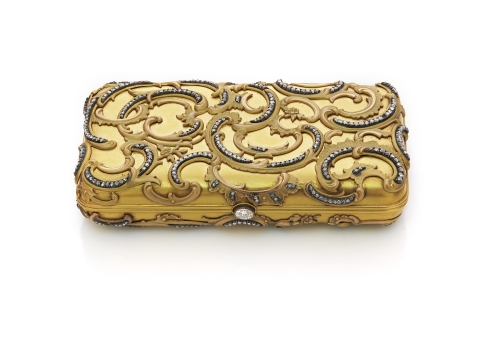
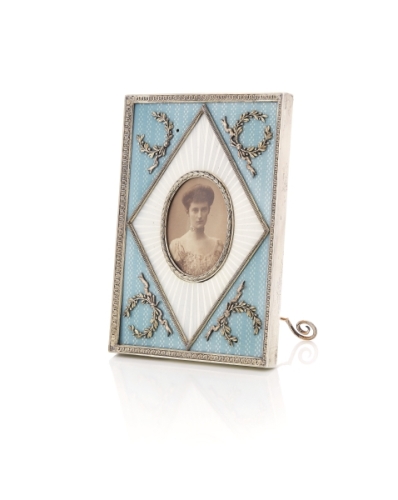
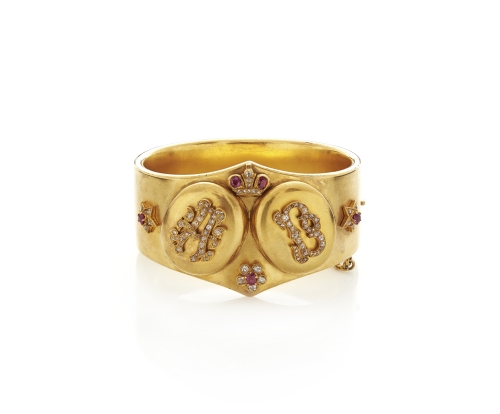
Fabergé
Who hasn’t heard of Fabergé? The jewelry firm was founded in Saint Petersburg, Russia, in 1842 by the Baltic German goldsmith Gustav Fabergé (1814-1893), whose ancestors were Huguenots from France. He married a Danish woman, Charlotte Jungstedt, and had two sons, Peter Carl (1846-1920) and Agathon Fabergé (1862-1895). In 1860 they retired to Dresden. Carl was educated in Saint Petersburg and Dresden. During his Grand Tour between 1864 and 1872 he enjoyed treasures in Florence, studied in Paris, and at goldsmiths in France, Germany and Great Britain. In 1872 he returned to Saint Petersburg. Until 1882 his mentor and tutor was the firm’s workmaster Hiskias Pendin. In 1882 Carl took over the business and became a Master Goldsmith. At the time also Agathon joined the firm. On 1 May 1885 Fabergé acquired the title of “Goldsmith by special appointment to the Imperial Crown” from Tsar Alexander III.
Carl Fabergé found the inspiration for his unique style among others in the Hermitage Collection. 1885 was also the year Tsar Alexander III commissioned the first Easter egg as a gift for his wife Maria Feodorovna. Since it became a tradition in the family that the Russian Tsar would commission an Easter egg for his wife (and mother). In total 50 Imperial eggs were completed for Alexander III and his successor Nicholas II. Most of them have survived. The example for the first Easter egg might well have been the French Easter egg of the Danish Princess Vilhelmina, daughter of King Frederik VI, made at the beginning of the 18th century. It is still part of the Royal Danish Collection. Although the eggs are probably the creations that made Fabergé famous, they produced also jewelry and other ornamental objects. In 1918 the House of Fabergé was nationalised. Carl Fabergé, his wife and eldest son Eugène fled Russia and via Latvia, Germany ended up living in Switzerland.
Carls younger sons Alexander and Agathon only managed to escape Russia years later. In 1924 Eugène and Alexander opened “Fabergé et Cie” in Paris, a company that existed until 2001. They however lost the right to use the trademark Fabergé for jewelry in 1984 in a lawsuit against Fabergé Inc., a company set up by Armand Hammer in 1936 and renamed in Elida Fabergé in 1989. The company merged with Lever Brothers in 2001 and became Lever Fabergé. Only in 2007 the company restored Fabergé to its rightful position and a reunification with the Fabergé brand of the Fabergé family – Carl Fabergés great-granddaughers Tatiana Fabergé and Sarah Fabergé – followed. The first collection of Fabergé Limited was launched online in 2009. A Fabergé museum can be found in Baden-Baden, Germany, another one in the Fabergé Museum in Saint Petersburg, founded by Viktor Vekselberg, where nine imperial Easter eggs are on display. Ten other eggs are to be found in the Armoury of the Kremlin in Moscow. After the Russian Revolution unfortunately lots of Fabergé objects have gone missing. The new regime took apart objects, but many people who left the country and smuggled their jewelry out of the country in some way. Still once in a while hidden objects are being discovered.
Koldinghus
According to their website the Koldinghus is the last royal castle of Jutland. In the mid-thirteenth century Kolding was situated at the border between the Kingdom of Denmark and the Duchy of Schleswig. The first Koldinghus was built in 1268 by King Erik Glipping (1259-1286) on this strategically crucial location to defend the border against the Dukes of Schleswig. There are no traces left anymore of this earliest building. After 1320 the castle fell into the hands of the Counts of Holstein several times. Only in 1348 King Valdemar Atterdag (1340-1375) managed to get the castle back. The lowest floors of the north wing were likely built during the reign of King Christoffer III (1441-1448) and the west wing during the reign of his successor King Christian I (1448-1481), who had come from Oldenburg. Extensive renovations were carried out under King Christian III (1536-1559), and the stronghold was changed into a residence for the King and his family. The medieval moat disappeared and the south wing was added. It was here that Christian III died in 1559. His wife Queen Dorothea used the castle as her dower house in the next twelve years. Their castle chapel, the first Protestant royal chapel in Denmark, was damaged by fire in 1581. Another fire broke out in the kitchen in the north wing in 1597. Therefore under King Christian IV (1588-1648) the castle was reconstructed and became not only a comfortable royal residence, but also suitable to carry out official functions. Among others the Great Tower was build and the chapel was enlarged. The castle also got a large ceremonial hall with a length of 57 metres. The stableyard in front of the Koldinghus still looks the same as in the times of Christian IV and his son King Frederik III.
Copenhagen in 1660 became the permanent residence of the Kings of Denmark and the importance of the Koldinghus as royal residence disappeared. Despite of that the Koldinghus under King Frederik IV (1699-1730) was once again modernised and got Baroque features. As the great hall was no longer needed, it was divided into smaller rooms. Unfortunately the castle was left in ruins after a fire that broke out on the night between 29 and 30 March 1808, when the troops of the French Emperor Napoleon I – mainly Spanish soldiers – were occupying the castle. Marshal Jean-Baptiste Bernadotte, the later King Karl XIV Johan of Sweden, was in residence that night. The castle remained mainly a ruin until in 1863 plans were made to rebuild the castle. The museum was founded in 1890. The final, complete programme of restoration work however only started in the 1970s. The castle is situated on a hill in the centre of the city of Kolding nowadays, with nice view on the castle lake.

Interesting article on rare insights into Faberge in Denmark. I am sorry for your injury and hope for speedy healing.
I discovered in my research on the Winter Palace a couple of Faberge items in the private rooms of Nicholas II.
https://winterpalaceresearch.blogspot.ca/2016/07/faberge-cigarette-case.html
https://winterpalaceresearch.blogspot.ca/2016/07/faberge-toothpick-holder.html
I linked to my Facebook to see if anyone knows of them or are the owners aware of their provenances.
Joanna